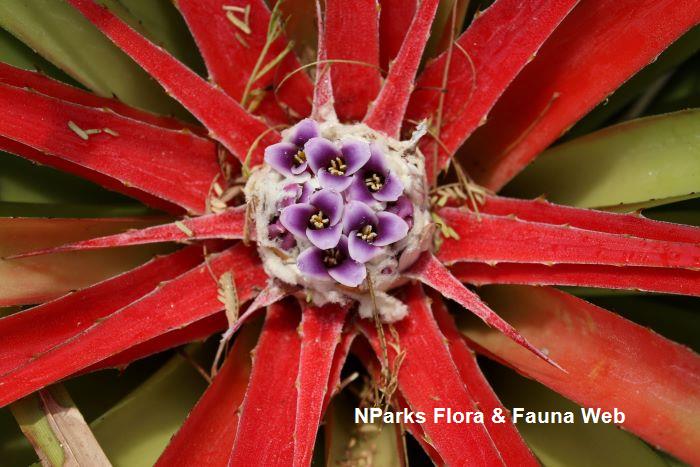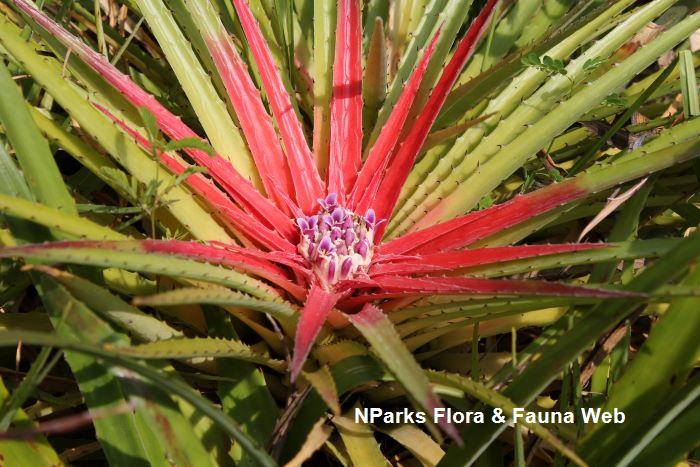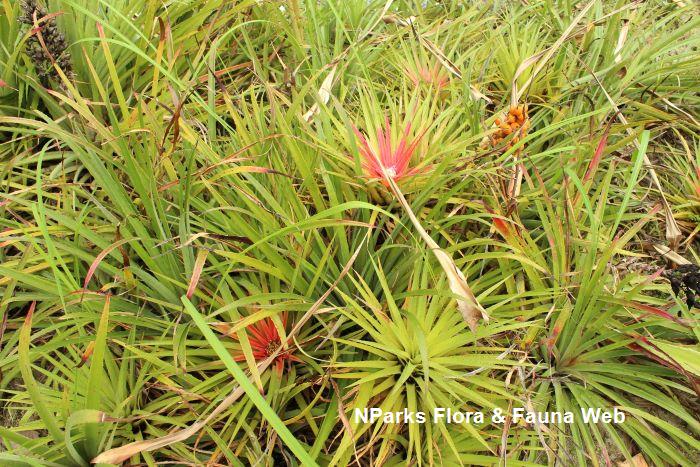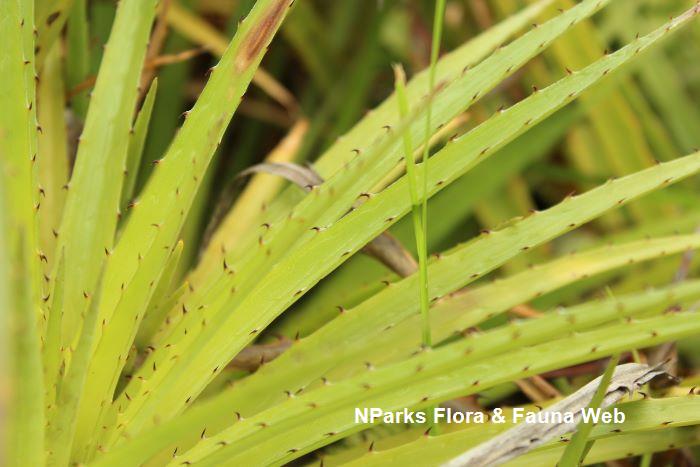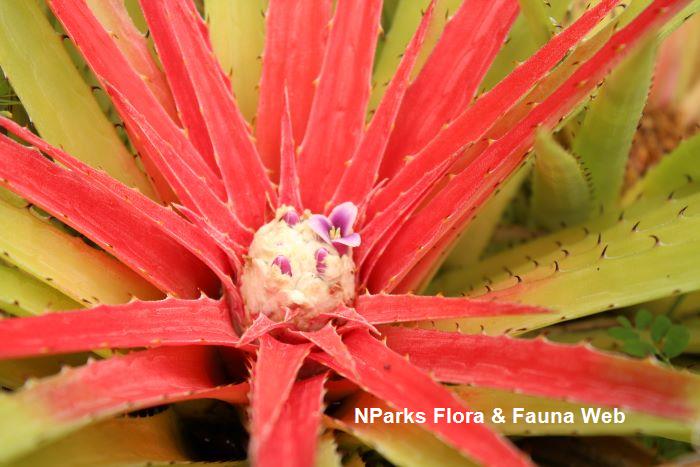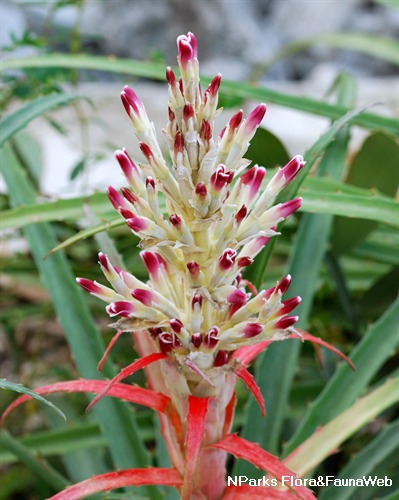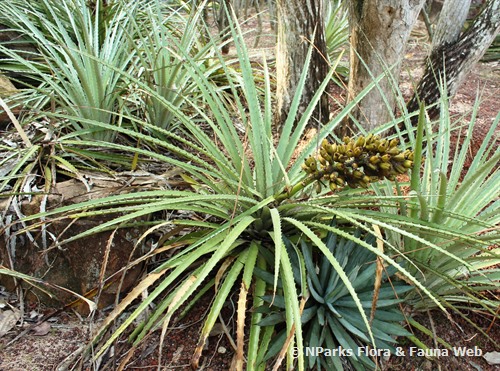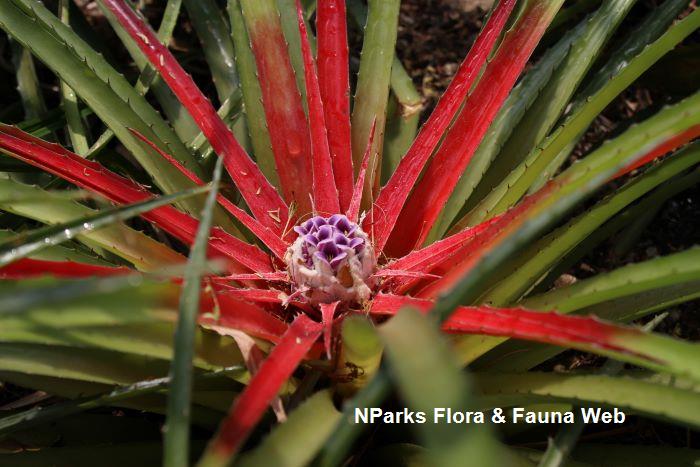
Back
Bromelia humilis Jacq.
| Family Name: | Bromeliaceae |
| Synonyms: | Bromelia lasiantha Willd. ex Mez, Nidularium humile (Jacq.) Regel |
Bromelia humilis is a low-growing bromeliad that spreads through stolons. Its spine-lined leaves grow in a rosette form and the innermost leaves turn red when the plant is in flower. Like most bromeliads, its roots are used mainly for anchorage and water is used attained from rainwater through its leaves.
Name
Classifications and Characteristics
| Plant Division | Angiosperms (Flowering Seed Plants) (Monocotyledon) |
|---|---|
| Plant Growth Form | Herbaceous Plant |
| Lifespan (in Singapore) | Perennial |
Biogeography
| Native Distribution | Netherlands Antilles, Trinidad-Tobago, Venezuela, Venezuelan Antilles |
|---|---|
| Native Habitat | Terrestrial |
| Preferred Climate Zone | Desert / Arid |
| Local Conservation Status | Non-native (Horticultural / Cultivated Only) |
Description and Ethnobotany
| Growth Form | It is a herbaceous plant with a rosette growth form that grows about 0.2-0.4 m in height. It spreads by sending offshoots from stolons. |
|---|---|
| Roots | Roots are fibrous, with adventitious roots sprouting as the stolons make contact with the soil. Roots are mainly for anchorage. |
| Foliage | The stiff, linear leaves are arranged in a rosette. Leaves at the outer rosette curve downwards, while the ones at the inner rosette are more erect. Leaves are spiny-edged with 3-4 mm long hooked spines, curving in both directions towards the leaf apex and the leaf base. When in bloom, the centre of the rosette turns bright red. |
| Flowers | Flowers are borne in a tight cluster at the centre of the rosette. A single flower consists of three purple and white petals. It is monocarpic, meaning it will die after it flowers. |
| Fruit | Fruits are yellow or orange when ripe. |
| Habitat | Sandy coasts, scrubs, and deciduous forests |
| Similar | Bromelia humilis can be differentiated from B. pinguin by its small size and compact inflorescence. |
| Cultivation | The plant grows best in well-draining, porous soil and in bright direct sunlight or under some light shade. Watering of the soil is not necessary as the plant absorbs water from its leaves. Lower leaves will naturally turn dry and remain on the plant; clearing dead leaves will be difficult due to spiny leaves but necessary for a neat appearance. It will die after flowering/fruiting but it can be propagated through offshoots. |
| Etymology | The genus Bromelia is named in honour of Olof Bromelius (1639-1705), a Swedish medical doctor and botanist. The specific epithet humilis refers to its low-growing habit. |
Landscaping Features
| Desirable Plant Features | Ornamental Flowers, Ornamental Foliage, Ornamental Form |
|---|---|
| Landscape Uses | Parks & Gardens, Coastal, Groundcover |
| Thematic Landscaping | Rockery / Desert Garden |
| Usage Hazard - Cons | Spines/Thorns - Leaf |
Plant Care and Propagation
| Light Preference | Full Sun, Semi-Shade |
|---|---|
| Water Preference | Moderate Water, Little Water |
| Plant Growth Rate | Moderate |
| Rootzone Tolerance | Drought Tolerant, Well-Drained Soils, Poor Infertile Soils, Saline Soils / Salt Spray |
| Potential Problems | Spiny leaves might make pruning of dried lower leaves difficult. |
| Propagation Method | Seed, Stolon / Runner |
Foliar
| Foliage Retention | Evergreen |
|---|---|
| Mature Foliage Colour(s) | Green, Red |
| Foliar Type | Simple / Unifoliate |
| Foliar Arrangement Along Stem | Rosulate / Rosette |
| Foliar Shape(s) | Non-Palm Foliage (Linear) |
| Foliar Venation | Parallel |
| Foliar Margin | Spiny |
| Foliar Apex - Tip | Acute |
| Leaf Area Index (LAI) for Green Plot Ratio | 3.5 (Shrub & Groundcover - Monocot) |
Non - Foliar and Storage
| Stem Type & Modification | Runner / Stolon, Shortened Internodes |
|---|---|
| Root Type | Underground (Fibrous Root) |
Floral (Angiosperm)
| Flower & Plant Sexuality | Bisexual Flowers |
| Flower Colour(s) | Purple, White |
|---|---|
| Flower Grouping | Cluster / Inflorescence |
| Flower Location | Terminal |
| Flower Symmetry | Radial |
| Inflorescence Type | Spike |
Fruit, Seed and Spore
| Mature Fruit Colour(s) | Orange, Yellow / Golden |
|---|---|
| Fruit Classification | Simple Fruit |
| Fruit Type | Fleshy Fruit |
| Plant Sexuality (non-Angiosperm) | Monoecious |
Image Repository
Others
| Master ID | 32758 |
|---|---|
| Species ID | 7170 |
| Flora Disclaimer | The information in this website has been compiled from reliable sources, such as reference works on medicinal plants. It is not a substitute for medical advice or treatment and NParks does not purport to provide any medical advice. Readers should always consult his/her physician before using or consuming a plant for medicinal purposes. |

